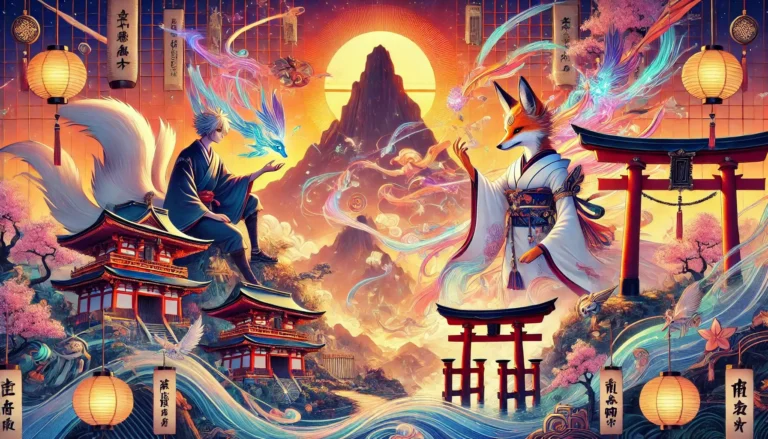In the vast realm of Japanese culture, where ancient folktales whisper through the winds and mountaintop shrines bask in the golden glow of dawn, manga stands as a modern heir to this legacy of storytelling. From the handscrolls of the Heian period to the ink-stained pages of bustling 20th-century studios, manga is a cultural bridge—rooted in the past, blossoming in the present, and casting its shadow on the future.
Much like the legendary Urashima Tarō, who traveled to an underwater palace only to find time had sped past upon his return, manga’s journey through history is both timeless and transformative. Its narratives are woven with strands of folklore, its artistry steeped in traditions, and its impact felt across the globe.
The Mythic Roots of Manga: Shadows of the Past
Manga’s lineage stretches deep into Japan’s artistic and narrative traditions. The Choju-Jinbutsu-Giga, whimsical scrolls from the 12th century attributed to monks of Kōzan-ji, depict anthropomorphic animals engaging in human-like antics. These scrolls, with their flowing brushstrokes and sequential storytelling, echo the spirit of manga’s visual dynamism.
Japanese folklore, rich with kami (spirits) and yōkai (supernatural creatures), permeates the early narrative DNA of manga. Consider the yōkai tales—shape-shifting kitsune (foxes) or the haunting yuki-onna (snow woman). Such stories find their modern parallels in works like GeGeGe no Kitaro by Shigeru Mizuki, where otherworldly beings inhabit a world at once humorous and ominous.
These folktales were more than mere entertainment; they were allegories, lessons, and mirrors of societal fears and hopes. In manga, this tradition of layered storytelling persists. Whether it is the existential dread of Neon Genesis Evangelion or the moral quandaries of Death Note, the modern medium retains an ancient soul.
Manga and Its Global Counterparts: Divergent Roads of Storytelling
Comparing manga to its Western counterpart, the comic, reveals distinct philosophies. Where Western comics—embodied by the likes of Superman or Batman—often celebrate the individual hero, manga revels in the collective, the journey, and the interplay of human flaws.
The influence of Buddhism and Shintoism often lends manga a meditative tone. Unlike the stark moral binaries of many superhero tales, manga frequently dwells in the gray. Consider Akira by Katsuhiro Otomo. While dystopian in its setting, its narrative grapples with collective trauma and rebirth, themes deeply rooted in Japanese culture.
Even the structure of storytelling diverges. Western comics traditionally employ episodic arcs, while manga unfolds like an epic—each volume a chapter in a larger tapestry, much like the oral recitations of Japanese storytellers, the biwa hōshi, who wove tales of heroes like Yoshitsune.
The Art of Appreciation: What Sets Manga Apart
Manga’s artistry is as vital to its identity as its narrative. The striking black-and-white panels, often mistaken as a limitation, are a masterclass in contrasts. From the gentle strokes of a shōjo manga like Cardcaptor Sakura to the stark, gritty lines of Berserk, the medium’s visual language is both versatile and evocative.
What sets manga apart is its ability to breathe life into the mundane. A ramen bowl glistening in the light of a bustling Tokyo street, the flutter of sakura petals in spring, or a lone character lost in thought beneath the moon—these are not merely scenes but emotions rendered in ink.
In this way, manga echoes ukiyo-e woodblock prints, like those of Hokusai or Hiroshige. Both art forms capture transient beauty, whether in the sweep of Mount Fuji or the fleeting glance of a protagonist.
Manga’s Legacy and Influence: A Global Resonance
Manga’s influence extends far beyond Japan’s shores, much like the ancient folktales of Momotarō, which spread across the regions of East Asia. From the 1980s onward, translated works like Dragon Ball and Sailor Moon introduced global audiences to the depth and diversity of manga.
Its influence is now seen in the rise of webtoons in South Korea, a digital descendant that blends manga’s visual storytelling with the scrolling nature of modern devices. Even Western animation has embraced manga’s aesthetic. The success of Avatar: The Last Airbender or Teen Titans owes much to Japanese manga and anime.
Yet, this global spread has sparked debates on authenticity. When Hollywood adapts manga—such as the controversial live-action versions of Ghost in the Shell or Death Note—critics argue that the cultural essence is lost, much like a folktale retold with missing verses.
More From Author: Mashle Magic and Muscles
Manga’s Future: A Myth Yet to Be Written
As we stand at the crossroads of tradition and technology, manga faces new challenges and opportunities. Digital platforms like Pixiv and ComiXology democratize access, enabling amateur creators to share their work globally. However, this also raises concerns about the erosion of manga’s tactile charm—its smell of ink and paper, the feel of turning a page.
Artificial intelligence, too, looms on the horizon. Could algorithms replace the human hand that draws with heart and soul? Or will they become tools for a new generation of storytellers, much as the printing press once was?
If manga is a living folktale, its future chapters will be shaped by both its creators and its readers. In this, it mirrors the cyclical nature of Japanese mythology—where endings are beginnings, and every hero’s journey leaves room for another to rise.
The Enduring Magic of Manga
Manga, at its heart, is an extension of Japan’s storytelling heritage. It is the shadow of Amaterasu, the sun goddess, as she emerges from her cave; the trickery of Susanoo, the storm god, in every unexpected plot twist. It is a mirror held to society, a canvas for dreams, and a refuge for those seeking solace in a chaotic world.
As the folkloric roots of Japan continue to entwine with manga’s modern branches, the medium becomes more than entertainment—it becomes a cultural artifact, a language that transcends borders, and a living, breathing myth of our times.
So, much like the wandering monk of old who stopped by a village to recount a tale, manga invites us to pause, to listen, and to see the world anew. Its stories will endure, just as the tales of yōkai and heroes echo through the ages.


